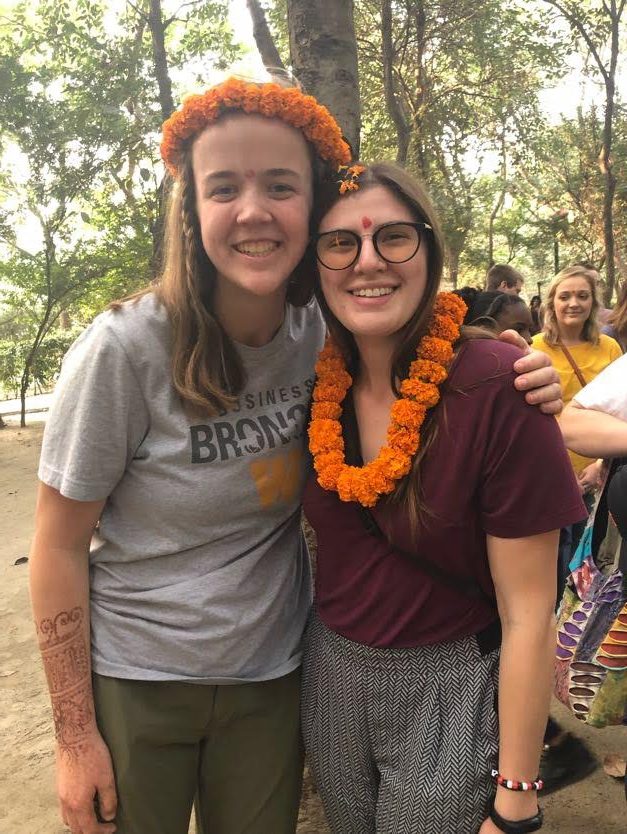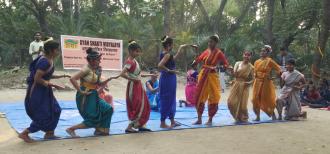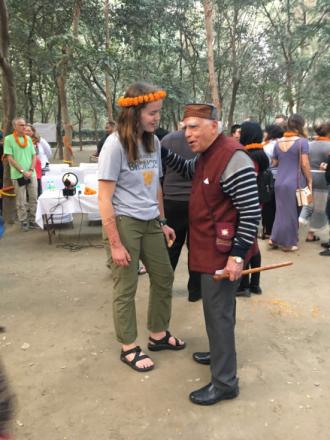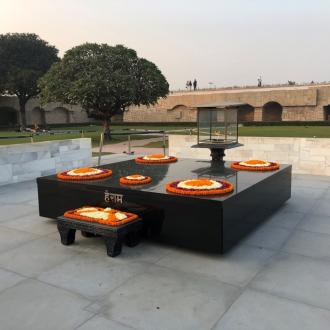IndiBroncos 2018: The Final Impact

Brenna Ingram
Marketing
Sustainability and Social Justice in India, Short-term, Fall 2018
The Final Impact
Waking up Thursday December 20th was like every other day. We had a four-hour bus ride from Agra to Delhi. The only thing on our itinerary for the day was visiting Gyan Shakti Vidyalaya (GSV), an after-school program for children 3 to 16 years old. GSV was our final NGO (non-governmental organization) we were visiting for the trip. Prior to heading to the school, we stopped for lunch, did a little bit of shopping, and got a little lost in the city.
Around 3 p.m. it was time to head to the Park School. Upon arrival to the park we were greeted with signs and chalk arrows pointing us toward the park school. We wandered past a community rose garden with a few community members admiring the beauty. Throughout the park there were dogs following us towards the destination along with strangers waving hellos as we passed park benches. Upon entering the park school, we were welcomed by a group of students who placed a marigold flower garland around our necks matched with a tikka. The children were so excited to have guests to their school and immediately began chatting with us, leading us towards a group of chairs set up in front of a stage. In front of the chairs were a line of tables with mango juice boxes and an array of homemade treats for us to try.
As our group got settled, one of the teachers of the schools welcomed us to GSV and introduced the students. The students range from 3 to 16 years old and include every grade from pre-school to high school. Gyan Shakti Vidyalaya was created to address the loopholes in government educated schools. Often times students attended GSV to hone in on a single skill they want to develop.
In order to fully welcome us to the school a few groups of students had created performances for us to watch. The first was a traditional Indian dance followed by a presentation by a theatre troupe on the negative effects of single-use plastics. This performance was done mostly in the Hindi language but it was easy to tell how passionate the students were about this subject, even with a language barrier.
The coolest part of this day for me, was to watch my friend Maggie interact with the students. Working with non-profits and children is something she is extremely passionate about and it is so inspiring to see her connect with students. She has a natural way of speaking and interacting with the students even when there is a language barrier. Throughout the trip she has inspired and encouraged me to go out of my comfort zone in order to make a bigger impact on both the students’ lives and my overall experience in India.
It’s also exciting to see her speak with the directors and founders of organizations like GSV because this is something that she wants to do in the United States. Hearing about her conversations with the founders of Gyan Shakti Vidyalaya and learning about how she wants to take the same principles home with her was extremely inspiring and a cool way to see how everything on the trip connects back to our own communities. I was able to better understand issues across the world that I didn’t even realize were issues and learn from greats about what we need in order to fix them. I learned from those who had been doing this kind of work for years, and those who are just starting to create change in their neighborhoods.
Mackenzie Tucker
Management
Sustainability and Social Justice in India, Short-term, Fall 2018
My Last Day in India
It is the final day in India, and some students are feeling the symptoms of homesickness, counting down the hours until they reach their own beds. The more I travel, the feeling of homesickness has gotten better, like an immunity. I created a space that felt familiar and home-y everywhere we stayed in India because of the group of friends I made and being open to the hospitality we were showered with by the people we met.
Honestly, our last day in India felt like a blur. I woke up, packed my belongings, went down to breakfast regrettably choosing American-style cooking instead of medu vada and coconut chutney, one of my favorites from south India, and then gathered in the lobby with the other students to take off on our last adventure.
We took a bus around New Delhi and Old Delhi just to sightsee and stop at different historical places. We went to the Qutub Minar, drove by government buildings and Red Fort, stopped at India Gate, and parked the bus by Jama Masjid, one of the largest mosques in India. From here, students could take auto-rickshaws through Old Delhi to the spice market. Honestly, I slept most of this bus ride as my late nights and early mornings started to catch up, and I stayed on the bus instead of going to the spice market with the other students.
If you are reading this blog because you are about to embark on a study abroad, or are travelling to India, or anywhere for that matter, it is okay to disengage once in a while during this time. Throughout the past two weeks I gave my full attention to every business and NGO we visited, went out with friends and pushed myself to the point of injury just to be a part of every single moment. I was exhausted, physically, mentally and emotionally, and I got more out of India through time spent with students at Christ University and at the NGO’s than when it was time to just be tourists. I’ll be able to come back to India and visit the spice market and stop at India Gate again, but will I be able to come back and play soccer with kids from the Parikrma Humanity Foundation school again? These last two weeks were so compact with educational and cultural opportunity, so my advice to anyone in a similar situation is to be mindful of where your energy is going during this time. That is how you will make the most out of it like I did.
The last place we stopped was of significance to me, and we only spent about fifteen minutes there. Raj Ghat is a memorial for Mahatma Gandhi’s cremation. It sits in a gated park with green open fields and large umbrella-like trees. When you get there, you walk by engraved slabs of marble with quotes by Gandhi written in Hindi and English. You go up a long stone-path ramp to the top of the wall which encircles the memorial to see an overview of the park. On a blanket under the shade of a tree were people praying off in the distance. People also walked up to the memorial to take pictures or selfies. It was quiet and peaceful as people respected one another as we honored Gandhi in our own ways as some sat and prayed and others glorified him through photos.
It was calming being there and appropriate for closing this chapter of travel. The theme for our study abroad was on social justice and sustainability in the developing world, and much of what inspires the NGO’s and businesses we encountered are values which Gandhi represents. As I am now a college graduate about to find my career or continue on in higher education, what I can take away from this journey is that there is optimism for change in the future, and if I can feel that in India, than I can take that with me anywhere.





